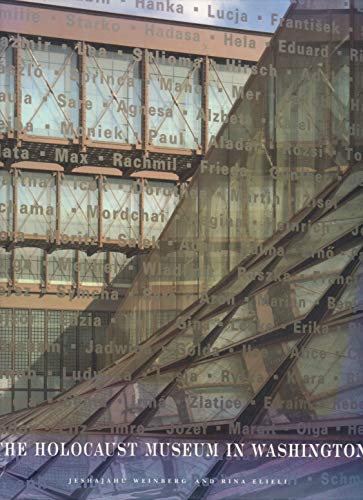holocaust pubns us (1 resultados)
Tipo de artículo
- Todo tipo de artículos
- Libros (1)
- Revistas y publicaciones
- Cómics
- Partituras
- Arte, grabados y pósters
- Fotografías
- Mapas
-
Manuscritos y
coleccionismo de papel
Condición
- Todo
- Nuevos
- Antiguos o usados
Encuadernación
- Todo
- Tapa dura
- Tapa blanda
Más atributos
- Primera edición
- Firmado
- Sobrecubierta
- Con imágenes del vendedor
- Sin impresión bajo demanda
Ubicación del vendedor
Valoración de los vendedores
-
The Holocaust Museum in Washington
Publicado por Rizzoli International Publications, Inc. In Collaboration with the U.S. Holocaust Museum, New York, 1995
ISBN 10: 084781906XISBN 13: 9780847819065
Librería: Ground Zero Books, Ltd., Silver Spring, MD, Estados Unidos de America
Libro Original o primera edición
Hardback book in slip case. Condición: Very good. Estado de la sobrecubierta: Very good. Presumed First Edition, First printing. Oversized book, measuring 12 inches by 9-1/4 inches. 200 pages. Illustrations (some in color). Signed and dated (10/26/95) by both co-authors on the front free endpaper. Includes Foreword by Chaim Potok, Preface, Creating a Living Museum, The Building, The Exhibition, The Values and Principles of a Living Museum, the Activities: Education, Collection, and Research; The People Who Did It; From the Books of Comments; and Index. This is the story of a monumental achievement--from the planning and construction of the museum, theater, conference center, and library; to the design and selection of the exhibits; to the participation of the first visitors. Jeshajahu "Shaike" Weinberg was the founding director of the U.S. Holocaust Memorial Museum in Washington. Mr. Weinberg, who had been a theater and museum director in Israel, came out of retirement and came to the U.S. 1988 as a senior consultant to the museum. He was recruited by the U.S. Holocaust Memorial Council in 1989 as the museum's first director, a job he held until 1995. Rina Elieli worked first as a clinical psychologist, and subsequently as a both a psychoanalyst and an organizational consultant. In the latter role, she worked with various organizations in industry, health, education, banking and art, both in Israel and internationally. One particularly notable and very public engagement was her three year consultation to the United States Holocaust Memorial Museum, which resulted in a major publication (1995) with the Museum's Director, J. Weinberg. - The Holocaust Memorial Museum in Washington. The United States Holocaust Memorial Museum (USHMM) is the United States' official memorial to the Holocaust. Adjacent to the National Mall in Washington, D.C., the USHMM provides for the documentation, study, and interpretation of Holocaust history. It is dedicated to helping leaders and citizens of the world confront hatred, prevent genocide, promote human dignity, and strengthen democracy. The museum was established as this country's institution for the study and documentation of the Holocaust and also as a study for the victims of Nazi horror. These included Jews, Gypsies and homosexuals as well as physically and mentally handicapped people judged as "subhuman" by the Nazi regime. Other groups included such Protestant sects as Seventh-Day Adventists. The museum has an operating budget, as of September 2018, of $120.6 million. In 2008, the museum had a staff of about 400 employees, 125 contractors, 650 volunteers, 91 Holocaust survivors, and 175,000 members. It had local offices in New York City, Boston, Boca Raton, Chicago, Los Angeles, and Dallas. Since its dedication on April 22, 1993, the Museum has had nearly 40 million visitors, including more than 10 million school children, 99 heads of state, and more than 3,500 foreign officials from over 211 countries. The Museum's visitors came from all over the world, and less than 10 percent of the Museum's visitors are Jewish. Its website had 25 million visits in 2008 from an average of 100 different countries daily. Thirty-five percent of these visits were from outside the United States. The USHMM's collections contain more than 12,750 artifacts, 49 million pages of archival documents, 85,000 historical photographs, a list of over 200,000 registered survivors and their families, 1,000 hours of archival footage, 93,000 library items, and 9,000 oral history testimonies. It also has teacher fellows in every state in the United States and almost 400 university fellows from 26 countries since 1994. Researchers at the United States Holocaust Memorial Museum have documented 42,500 ghettos and concentration camps erected by the Nazis throughout German-controlled areas of Europe from 1933 to 1945.


